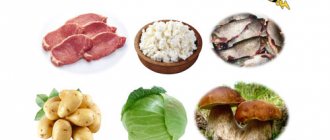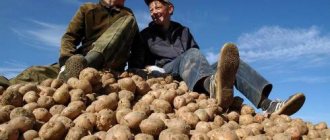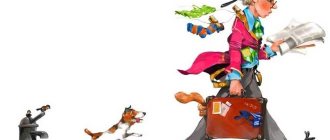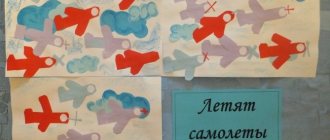Progress of the lesson.
All things are closed before
. Things should hang on hangers so that all children can see.
The teacher opens things for the children.
Guys, what do you see here?
/Dress, shirt, etc./
Look at the dress and skirt, how are they different? How are they different /Children's answers/.
What is the difference between trousers and shorts?
Are there any objects here that are somewhat similar?
- / A fur coat, a dress, a shirt have sleeves, a collar /
What else does a dress, shirt and fur coat have?
— / Clasp, buttons /
Take a close look at the sleeves of the dress and shirt and tell me how they differ? /Children's answers/
The sleeves of the dress are without fastening, and the sleeves of the shirt are buttoned. The shirt sleeve closure is located at the cuff. This part of the shirt where the buttons and buttonholes are is called the cuff. Repeat
this word is all together.
Tolya, where are the buttons and loops on the sleeve of the shirt? /on the cuff/
Sveta, what is the name of the detail on the sleeve where the clasp is located?
Look at your shirts and dresses. Do any of you have cuffs on your sleeves? The sleeves of the dress may also have cuffs. / Children look at their dresses and shirts and learn a new word /
What is the difference between a fur coat and a dress? / They wear a fur coat when they go for a walk, etc. /
And the fur coat and dress are made from different materials. What is the dress made of? / From fabric /
What is the fur coat made of? / From fur /
How is fur different from fabric? /It is soft, fluffy, warm /
We looked at all these objects, and you saw that they are both different from each other and somewhat similar. Why do we need all these items? / To put on yourself /
Everything that we put on ourselves that protects us from cold, heat, rain can be called in one word - clothing
.
Repeat it all together
.
We put clothes on the body
.
We have some clothes
, what other
clothes can you name
? / jacket, tights, coat, raincoat, etc. /
And now we will play “Shop”
.
On the tables in the group there are pictures
on which not only items of
clothing
, but also other items.
Now you will get up, go to the tables and take only one picture on which clothes
and bring them to the
Clothes
store for
me. / The children complete the task, the teacher, accepting the picture from the children, asks why they decided that these were clothes /
.
So, guys, today you learned that those items that we put on ourselves are called in one word - clothes
.
Clothes are made from fabric
, fur and other materials.
It is sewn by adults. Sewing clothes is very difficult
.
If a person sews a dress incorrectly, for example, makes one side shorter than the other, you will not wear such a dress. People put a lot of work into making sure you and I wear beautiful clothes
.
Your parents work to earn money and buy you the clothes
.
Therefore, you need to treat your clothes
very carefully and carefully.
When you come from the street, you need to carefully hang your jacket or fur coat on a hanger, and carefully fold your pants. When you undress before going to bed, your clothes
should also be folded on the high chair.
When you play, draw, eat, try not to get your clothes
.
Then your clothes
will serve you for a long time, and you will always be beautiful and fashionable.
Publications on the topic:
Summary of an integrated lesson on the surrounding world Topic “Stones” Summary of an integrated lesson on the surrounding world Topic “Stones” Purpose: Educational: To promote the consolidation of knowledge and ideas.
Lesson notes on the world around us Purpose: 1. To consolidate children’s knowledge about poultry. 2. Introduce wild birds. 3. Consolidate knowledge about the distinctive features of birds.
Summary of a lesson on the surrounding world in the second junior group “A small match” Goal: to develop children’s knowledge about fire safety rules. Objectives: to give an idea of what danger is fraught.
Summary of a lesson on the surrounding world “Water Sorceress” Program content: 1. Introducing children to the properties of water (fluidity, steam, ice, can dissolve (not dissolve, change its color, shape, taste).
Summary of a lesson on familiarization with the outside world “Wintering birds” Purpose: 1. To consolidate the concept of “wintering birds”; 2. Give children an idea of the types of food of wintering birds; 3. Expand your vocabulary: food,.
Summary of a lesson on the surrounding world in the middle group Topic Autumn Objectives: to consolidate children's knowledge about the signs of autumn, to consolidate.
A child-parent project on the theme of a hat and a fur coat - that’s the whole bear.”
(first group of early childhood) Project participants:
teachers, children of the 1st group of early development, parents
Description:
In this publication I offer you the project “A hat and a fur coat - that’s the whole bear,” aimed at children’s understanding of clothing.
Publication for teachers working with young children. Purpose of publication:
dissemination of teaching experience.
Type of project:
educational, short-term, creative.
Duration:
from 01/15/2018 to 01/31/2018
Participants:
educators, parents, children.
Integration of educational areas:
Cognitive development, speech development, artistic and aesthetic development, physical development, social and communicative development.
Goal:
creating conditions for the development of children’s cognitive and creative abilities as part of the project.
Objectives:
To form children’s ideas about clothing and its purpose;
Replenish and activate vocabulary; Develop coherent speech; Cultivate a caring attitude towards items of clothing, the ability to take care of one’s appearance; Improve self-care skills when dressing. The main directions of the project: Conversations with children “People’s clothing at different times of the year”, “Fur coats for animals”, “Clothes for girls and boys”. Homework for parents and children - reading poetry together, composing riddles on the topic of the project, making doll clothes, clothes for the “mummering corner” Reading fiction. Provision:
printed board games, illustrative and visual material, children's fiction on the topic of the project, special methodological literature.
Expected result:
Know and name items of clothing;
Possess a general concept; Distinguish between clothes for boys and girls; Identify items of clothing by descriptive riddles; Products of project activity:
Illustrated album “Clothing” with thematic poems and riddles;
Making doll clothes; Equipment in the “Mumming Corner” group. Activities for the implementation of the project:
Compiling an album “Clothing”
Sensory Center:
1. Reinforcing the concepts of “wide”, “narrow”, “long”, “short”, “high”, “low”;
2. Reinforcing the concepts of “one-many”. 3.Fixing the color. Communication Center
1. Memorizing the poem by L. G. Paramonova “Clothes include...”;
2. Guessing riddles; 3. Conversations on the topic: “Children’s and adult clothing”, “Clothing for the season”, “Clothing for girls and boys”, “Fur coats for animals”. Center for Fiction
1. Reading the poem by B. Zakhoder “The Dressmaker”;
2. Reading of P. Voronko’s poem “New Things”; 3. Reading the story by L. Voronkova “Masha the Confused”; 3. Reading the story by I. Pavlova “Whose shoes? " Art Center
1. Drawing “Doll Clothes”;
2. Application “Let’s dress the dolls for a walk”; 3. Coloring books, stencils on the theme of the project. Construction Center
1. “Wardrobe for doll clothes” (large building material);
2. “Shoe rack” (artistic design). Game activity center
Didactic games: “How do your things live”;
“What's too much? "; “Who needs what for work? "; “How do we dress? » “Say it in one word” Finger gymnastics “Glove” Theater Activity Center
1. Game-dramatization based on the Russian folk tale “Rukavichka”;
2. Puppet theater show based on the Russian folk tale “Rukavichka”; 3. Development of the storyline “Let’s dress the doll for a walk...”. Literary support for the project: L. G. Paramonova
Clothes include trousers, vests Dresses, suits, coats and jackets We wear warm fur coats in the winter, And we switch to raincoats in the spring.
B. Zakhoder “The Dressmaker”
I've been sewing all day today.
I dressed the whole family. Wait a little, cat, - There will be clothes for you too! P. Voronko “New thing”.
I bought boots for the cat for the holiday.
I combed her mustache and sewed new panties. But how to put it on? There's nowhere to put the tail! L. Voronkova “Masha the Confused”
Once upon a time there was a girl Masha.
In the morning the sun rose and looked in the window. And Masha is sleeping. Mom came: “Masha, get up, Masha, get dressed!” The sun is shining in the morning, it's time to go to kindergarten! Masha woke up, opened her eyes: “I won’t get tired when I get up.” I’ll lie down for a while and look out the window. And mom again: “Masha, get up, Masha, get dressed!” There is nothing to do - we need to get up, we need to put on stockings. Masha looked around - but there were no stockings! - Where, where are my stockings? I'll search every corner. They are not on the chair, And they are not under the chair, They are not on the bed, They are not under the bed... Masha is looking for stockings, but she can’t find them. And the cat on the chair purrs and says: “You look, you look, but you won’t find it, But if you find it, you’ll go.” You need to put things away - you don’t have to look for them. And the sparrows outside the window tease Masha: “You’ll be late, Masha, confused Masha!” And Masha is still looking: - And there’s nothing under the chair, And there’s nothing on the chair... But here they are - in the doll’s crib! Mom asks: “Masha, soon?” And Masha answers: “I put on stockings and put on shoes.” I looked under the bed, and there was only one shoe there, and no other! - It’s not under the bed, It’s not on the bed, And it’s not behind the closet, And it’s not under the closet... And the cat walks around, purrs everything and says: - You look, you look, but you won’t find it, But if you find it, you’ll understand. You need to put things away - you don’t have to look for them. A cockerel came up to the window and sang: “You’ll be late, Masha, confused Masha!” Masha began to ask for the cockerel: “Cockerel, cockerel, find my shoe!” The cockerel searched and searched - there was no shoe in the yard. And that’s where the shoe is – on the table. Mom asks: “Masha, soon?” And Masha answers: “I’ll put on a dress and go for a walk!” And the dress is nowhere to be found either! – What should I wear for a walk? Lost dress! Polka dot dress - Where is it put? And there’s no one on the chair, And there’s no one under the chair... And the cat keeps purring and saying: - You look, you look, but you won’t find it, And you won’t go without a dress... You need to put things away - You won’t have to look for them... You’ll be late, Masha, Masha the Confused One! But then Masha saw her dress. She was delighted: - The polka dot dress has been abandoned on the shelf! Mom says: “I can’t wait any longer!” And Masha answers: “I’m running, running, running!” Masha runs to kindergarten, in a hurry. And the children in kindergarten had already had breakfast and went for a walk. They saw Masha and shouted: “I’m late, Masha, confused Masha!” I. Pavlova “Whose shoes?”
Our shoes are on the window. The pussy jumped onto the window. Sniffs our shoes. - Shoo, shoo, pussy! Don't smell our shoes! Shoo, shoo! Pussy got scared. The pussy turned around, pushed her shoes and - jump! - on the floor. And the shoes - boom! - into the yard.
The goose approached the shoes: “Ho-ho-ho!” Put your feet on my feet! - No, we won’t put it on: your legs are red, there are rags between your toes. No, we won’t! - Go Go go! Be hopeful! - Shoo, shoo, goose! Stay out of our shoes! Shoo, shoo! So the goose ran away. The shoes are lying in the yard and crying: “Where are the feet?” Who do we rely on? - The cockerel came up to the shoes: - Ko-ko-ko! Put your feet on my feet! - No, we won’t. Your legs are smooth like sticks, and your toes have sharp claws. No, we won’t! - Ko-ko-ko! Be hopeful! - Shoo, shoo, cockerel! Don't interfere with our shoes. Shoo, shoo! So the cockerel ran away. The shoes are lying in the yard and crying: “Where are the feet?” Who do we rely on? The dog came up to the shoes: “Woof-woof-woof!” Put your feet on my feet! - No, we won’t: your legs are shaggy, there’s fur everywhere and you can’t see your toes. - Doggy, doggy, take your shoes. Bring them to us. Here is our baby. Waiting for his shoes. The dog listened and took her shoes in her teeth. - Go, go, doggy! Come, come to us! So the dog brought our shoes home! Now where are the shoes! On whose legs!
Abstract of educational activities on cognitive development for children 3-4 years old on the topic: Clothing
Summary of educational activities on cognitive development for children of the younger group “Clothing”.
Objectives: 1. Develop children’s ability to listen carefully to the teacher and answer questions asked. 2. Encourage children to name items of clothing. 3.Develop brush painting skills. 4. Develop interest in visual arts. Progress of the lesson (the teacher enters with a parcel containing children's clothes, cards with images of clothes and sheets of paper for each child in the form of a dress). Educator: Guys, they brought a package to our group that says: “For the youngest children in kindergarten.” Do you think this was sent to our group? Children: Yes, because we are the smallest children in kindergarten. Educator: Well, then I’ll open this parcel (he opens it, and there are different clothes in it). Guys, what is this? (shows the children items of clothing). Children: This is a dress, pants, blouse, hat, shorts, jeans, T-shirt, jacket, mittens. Educator: Correct, but how can you call all this in one word? Children: Clothes. Educator: Who will wear these clothes? Children: These clothes are worn by boys and girls. Educator: Name the clothes that girls can wear. Children: Dress, T-shirt, skirt, sundress. Educator: Correct, what clothes do boys wear? Children: Jeans, T-shirts, shorts. Educator: Well done, guys. There are also clothes that are designed for each season. Now we will play a game in which we need to distribute clothes into winter and summer. You need to attach winter clothes to the easel where the snowflake is depicted. And on the easel with the sun, you need to attach summer clothes (children take cards with images of clothes and distribute them on the easels). Game: "Distribute the clothes." Educator: You distributed the clothes correctly, well done. But I see in the parcel there are some leaves, it is written that they need to be beautifully colored. What do these sheets of paper look like? Children: On the dress. Educator: That's right, but girls wear beautiful, bright clothes. Let's paint our dresses in bright colors, but first let's stretch our fingers and do some gymnastics. Finger gymnastics: “I’m putting on a glove” I’m putting on a glove, I don’t fall into it.
They stroke the other with one hand in turn, as if putting on gloves. Guys, count how many fingers the glove has. We begin to count out loud: One, two, three, four, five. Bend your fingers. (Children sit at tables and paint dresses using bright colors, the teacher helps them use familiar patterns).
Educator: Well done, guys, you made very beautiful and bright dresses for girls. Did you enjoy coloring? Did you like looking at the clothes? Let's hang your dresses at our exhibition.
We recommend watching:
Summary of GCD for mathematical development in the first junior group. Summary of GCD for the junior group of a preschool educational institution on the topic “Parrots.” Summary of a lesson in the junior group of a preschool educational institution. Taking care of the book Summary of a lesson with children of the younger group on the topic: Squirrel in the forest
Similar articles:
Summary of an integrated lesson in the 2nd junior group





